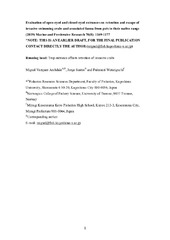Evaluation of open- and closed-eyed entrances on retention and escape of invasive swimming crabs and associated fauna from pots in their native range
Permanent lenke
https://hdl.handle.net/10037/17917Dato
2019-03-29Type
Journal articleTidsskriftartikkel
Peer reviewed
Sammendrag
Fishing trials targeting several invasive swimming crab species in their native habitat were undertaken using two types of collapsible pot, one with open-eyed entrances and the other with closed-eyed entrances, to analyse differences in catch retention between them. The open-eyed pot was dome-shaped with two funnel entrances located at opposite ends, whereas the closed-eyed pot had two soft sleeves that ended in slits and had to be pushed through by organisms to ingress, supposedly reducing escape. Retention fishing trials (100 pot hauls per pot type) using a 1-day soaking and fish bait confirmed no significant difference in crab catches between pot types; differences were only detected for large fish (morays and congers). A second set of 4-day escape trials (20 pots per type) was undertaken to investigate how long organisms would be detained in the pots. Escape was significantly affected, and half-residences were typically delayed by 1–2 days for most crabs and fish in closed-eyed entrance pots because the entrances closed. Closed-eyed entrances hampered escape and may be useful when longer soakings are needed; however, because no differences were detected in crab numbers between the two entrance types for short soakings, we recommend open-eyed entrance pots in order to mitigate possible ghost fishing effects from lost gear.
Forlag
CSIRO PublishingSitering
Vazquez-Archdale M, Santos aj, Watariguchi F. Evaluation of open- and closed-eyed entrances on retention and escape of invasive swimming crabs and associated fauna from pots in their native range. Marine and Freshwater Research. 2019;70(8):1169-1177Metadata
Vis full innførselSamlinger
Copyright 2019 CSIRO Publishing


 English
English norsk
norsk